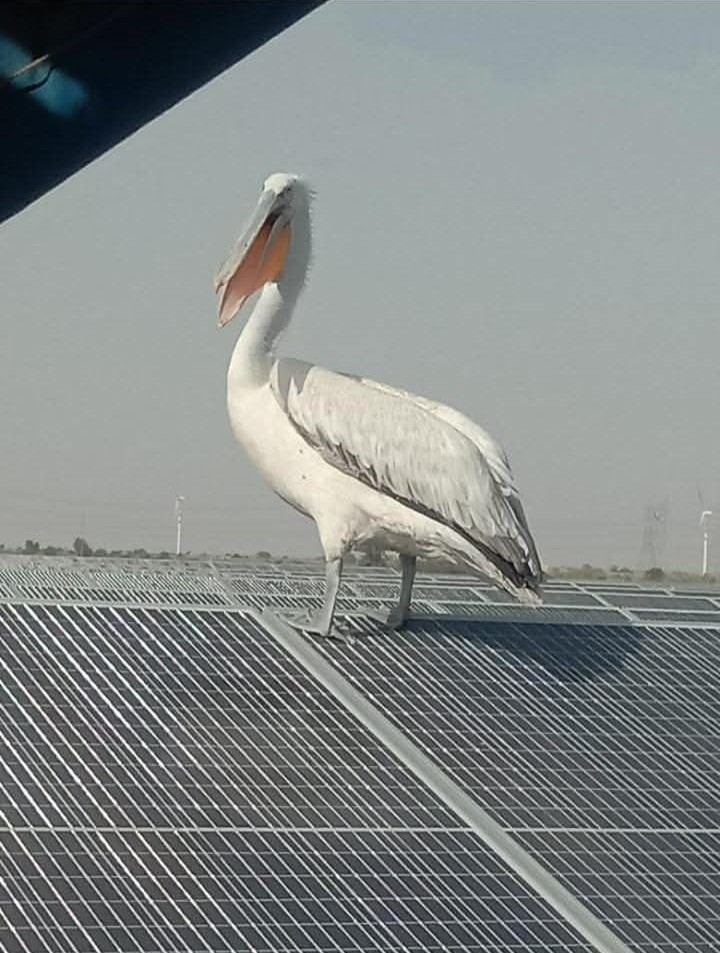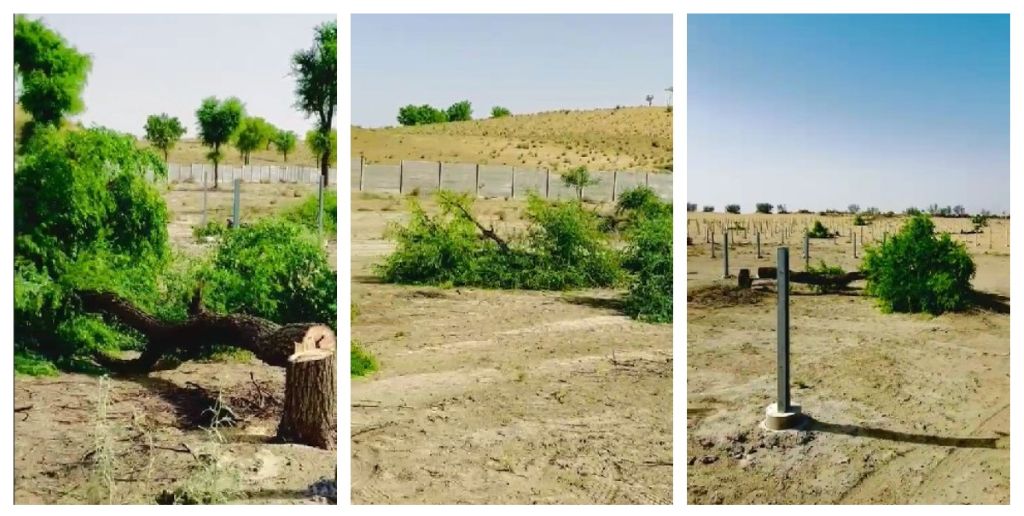How Solar Power Plants in Rajasthan Are Affecting Local Flora and Fauna
This article is the second in The Wire Hindi's series on the growing crisis in the desert region. Read the first here.
Jaipur: Radheshyam Pemani, a resident of Dholia village in Jaisalmer, was an enthusiastic amateur photographer. In recent years, several solar power plants have been set up in the Dholia area, prompting him to capture some distinctive scenes with his camera.
One evening, he observed a group of pelicans descending onto a field covered with solar panels. Previously, the area had been home to several brimming ponds, but now solar panels stretched across the landscape. The pelicans mistook the gleaming panels for a body of water at night. As one bird attempted to land on the glass surface, it slipped and injured its feet.
Pemani had been gathering stories like these. On May 23, Pemani died in a road accident while attempting to rescue a deer from poachers.
§
The Wire Hindi previously reported on the effects that the construction of numerous solar power plants has had on the social structure of the desert. In this report, we examine their environmental repercussions.
Ummedaram and Hanumanaram, who tend to sheep, goats, cows, and camels in this region, report that unique birds were once spotted in Rohi, which is at a slight distance from the village, but now none are visible. Since the installation of electric cables and the introduction of solar lights in the area, taking animals out to graze has become increasingly difficult.
The allocation of land for extensive solar power plants in remote areas of Rajasthan is deepening the crisis, affecting both pastures and sacred forest lands known as orans. This concern has echoed through rural communities in Barmer, Jaisalmer, Bikaner, and Jodhpur for a long time. The issue also gained traction in the Rajasthan assembly, where on March 21, during the discussion on the Land Revenue and Law Validation Bill 2025, Ravindra Singh Bhati, an independent MLA from the Shiv constituency in Barmer, launched a scathing attack on the government.
He accused the state government of surrendering the land of western Rajasthan to multinational corporations.
Crisis looming over pastures and oran land
The pastures and orans of Barmer and Jaisalmer are under significant threat. Large-scale protests against solar power projects have erupted in numerous villages including Shiv, Bhairupura, Hadwa, Devka, Manihari, Mati Ka Gol, Jhaloda Bhatian, and Mokla.
Local activist Bhopal Singh Bhati, who is spearheading the movement, said, “This process has been ongoing since 2010–11. Over 1.57 lakh bighas of land have been allocated to various companies to date.”
“We should not be subjected to injustice in the name of development,” Bhati added. “If the entire region is overrun with solar plants, where will our livestock go? What will become of our grazing lands and forests?”
Recently, members of the All India Jeev Raksha Bishnoi Sabha met with Union home minister Amit Shah to raise the issue. Sabha spokesperson Shivraj Bishnoi said they have called for an immediate halt to the cutting of trees wherever solar companies are establishing plants in Rajasthan.
Environmental threats from solar energy projects
Experts have warned that the establishment of solar plants is destroying pastoral land, posing a significant threat to biodiversity. Dr. M. L. Parihar, a senior veterinarian in Rajasthan, cautioned, “The natural vegetation that supports animals is being eradicated because of solar plants. Khejri trees, essential to the desert ecosystem, are being extensively felled.”
Wildlife expert Mridul Vaibhav noted, “In Rajasthan, numerous species such as wild pigs, langurs, black deer, desert cats, desert foxes, chinkaras, and the great Indian deer are struggling to survive.”

A pelican at a solar plant. Photo: Radheshyam Pemani.
“Many species in these regions of Rajasthan are already battling for their existence. According to a 2018 study by our Wildlife Institute of India, power lines are proving deadly for Rajasthan’s bustards, resulting in the deaths of 84,000 birds annually within a 4,200-square-kilometre area surrounding Jaisalmer’s Desert National Park. Such a high mortality rate among bustards in recent years is unsustainable for the species and poses a definite risk of extinction.”
Vaibhav cited reports including 'Power-line Mitigation to Conserve Bustards' and 'Survey Report: Status Survey of Migratory Birds and 'Key Wildlife in Bikaner Rajasthan,' both from the Wildlife Institute of India, to argue that the situation has further deteriorated.
The concern is not limited to independent or Congress legislators. BJP lawmakers have also expressed alarm.
On July 31, 2024, Chhotu Singh, the BJP MLA from Jaisalmer, brought the issue to the assembly’s attention.
“As a result of the allocation of command land in the canal area and the distribution of lakhs of bighas of land for wind and solar energy projects, sewan grass has disappeared. Millions of animals are facing a threat to their existence. Grazing lands have diminished. Animal herders are either compelled to migrate or abandon their profession. If this trend continues, it will not be long before the unique livestock of this region faces extinction. The natural pastures and forests in desert districts should be designated as protected areas and promptly recorded, while energy companies should be allocated only rocky, hilly, and barren land far from natural sewan grass regions, pastures, and forests.”
Rajasthan, unimaginable without the Khejri tree which is ubiquitous in the state, is currently enduring the brunt of the current administration’s policies. In 2023, 60,000 Khejri trees were cut down in Bikaner for a solar energy initiative.
Vishwanath Meghwal, the MLA from Khajuwala, also emphasised that while energy generation is necessary, the illegal cutting of 50,000 to 60,000 Khejri trees constitutes environmental devastation.
“In 1730, 363 individuals sacrificed their lives for a Khejri tree,” he said. “And now, everything is being mercilessly destroyed.
Khejri (Prosopis cineraria), considered the life-giving tree of Rajasthan, is the official state tree and known locally as the “Kalpavriksha of Marudhar.” It flourishes in arid environments and improves soil fertility. Its foliage is used as feed for camels, goats, and sheep, while its fruit (sangri) is a key ingredient in the traditional panchkuta dish. For generations, it has provided both fodder and food.
The tree plays a crucial role in environmental preservation and is honored by the Bishnoi community. In 1730, Amrita Devi and other Bishnoi villagers sacrificed their lives to protect it. The wood of the Khejri tree has been used in rituals since Vedic times. Few tree species are resistant to pests, making Khejri wood ideal for use in ceremonial fires and religious practices.

Khejri trees were recently felled at the Lakhasar Solar Plant in the Bikaner region. Photo: Special Arrangement.
A popular anecdote illustrates the deep connection Rajasthani people share with the Khejri tree. Maharaja Ganga Singh of Bikaner, who led the camel-mounted Ganga Risala regiment during World War I and World War II, once came across a Khejri tree in Europe. Seeing it reminded him of home, and he embraced the tree as if it were his mother.
Prithvi Singh, the district harmony president of the Vishwa Hindu Parishad, recently stated that solar energy companies have cut down thousands of Khejri trees along Joranada Road in Shiv tehsil, Barmer.
Existence of rivers in danger
A senior official in the forest department said, “It appears that the efforts to transform the desert into a unique forest region have failed. Vested interests now target every corner of the desert. Concerns are growing about the future of the Luni River, which has historically supplied half the region’s food. Smaller streams such as Lik, Ranigaon Nala, Kavas Nala, and Khorayal Nala, which fill during the monsoon, are also at risk. Although Barmer is a desert district, it is home to many significant rivers, drains, and seasonal water channels.”
The Luni River, the largest and most historically significant river in the region, originates in Ajmer and flows through several districts into Barmer. It has long served as a lifeline for agriculture, irrigation, and traditional livelihoods.
Shepherds and local residents are also concerned about seasonal rivers such as the Sukdi and Meethadi. Dalit activist Bhanwar Meghvanshi has pointed out that in the name of solar energy development, catchment areas, foothills, and adjacent lands are being allocated to private companies. The levelling of land, construction of boundary walls, and use of heavy machinery risk altering the natural course of rivers and may cause serious ecological disruption.
The threat has grown so severe that, in the coming years, Barmer’s traditional water culture, pasture-based animal husbandry, and rural way of life may face total upheaval. Under these circumstances, preserving ecological balance and safeguarding water resources must take precedence in the push for solar energy.
Flora and fauna must be preserved
When The Wire Hindi interviewed local shepherds and herders, they expressed concern that trees such as Sandeshara, Morli, Arani, and Farash are under severe threat. The fencing erected by solar companies has led to the disappearance of native grass species including Dhaman, Bhurat, Bhakhri, Beldi, Tantiya, Bikariya, Sewan, Makda, Mothia, Lamp, Kuri, Gramna, Dhamasa, and Kami, all of which are essential for livestock in this region.
Bird watchers are also raising alarm. They report that deforestation is threatening species such as the Neelkanth, hoopoe, bulbul, robin, great Indian bustard, sand grouse, chakwa, chakor, duck, nyukta, gadwall, pintail, wigeon, pochard, teal, swan, imperial sand grouse, vore, quail, rain quail, florican, sarus, karkare, and starling.
For centuries, the people of Barmer and Jaisalmer have survived famine, drought, and scorching heat. But now, their very existence is under threat, much like the sand dunes of the region, which scatter silently and helplessly with the wind.
Tribhuvan is a senior journalist.
Translated from the Hindi original, which was first published on The Wire Hindi, by Naushin Rehman.
This article went live on June twenty-fourth, two thousand twenty five, at zero minutes past twelve at noon.The Wire is now on WhatsApp. Follow our channel for sharp analysis and opinions on the latest developments.




